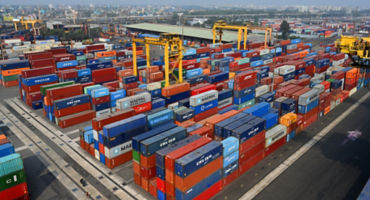- Global Investment and Multi-Asset Strategist
Skip to main content
- Funds
- Capabilities
- Insights
- About Us
Asset classes
Hong Kong (香港), Individual
Changechevron_rightThe views expressed are those of the author at the time of writing. Other teams may hold different views and make different investment decisions. The value of your investment may become worth more or less than at the time of original investment. While any third-party data used is considered reliable, its accuracy is not guaranteed.
Tariffs exceeded market expectations. Now what? Expect short-term volatility, identify concentrations, and consider using sell-offs as an entry point to diversify across regions and styles.
Overall, tariffs announced by the US administration on April 2 far exceeded market expectations. This is because while universal tariffs of 10% were lower than expected, “reciprocal tariffs,” especially in Asia, were higher than expected. China, Vietnam, India, Thailand, and Taiwan were particularly hard hit by reciprocal tariffs, with China's effective rate now sitting at 54% given an imposition of 20% earlier this year.
The US is likely to see lower growth and higher inflation. As a result, the risk of a recession in the US is higher — I currently place it at a 50% probability — with the fallout affecting other economies across the globe to a varying degree. In the event that unemployment rates in the US rise, the US Federal Reserve (Fed) does have room to lower interest rates from its current rate of 4.5% but higher potential inflation will act as a constraint.
Other developed markets, most notably Europe and Japan, look increasingly attractive. While the US faces fiscal contraction, Europe is moving toward fiscal expansion — especially following recent policy shifts in Germany — with Japan also benefiting from fairly accommodative policy. Both regions offer relatively cheaper valuations than the US. Further declines in the US dollar would be a tailwind for the rotation into non-US developed markets.
Review portfolios and identify concentrations – many portfolios are still quite concentrated in US and growth, yet the opportunity set may now be much more broad-based.
Clarify investment horizon and risk tolerance – longer investment horizons and a tolerance for risk give many investors more flexibility to use volatility as an opportunity. It may make sense even for investors with shorter time horizons to ride out the storm and avoid crystalizing losses that may get smoothed out over time.
Make a plan – not doing anything is a decision. It’s better to set a plan to become more diversified across regions and styles. With a longer horizon of a over a year, consider using sell-offs as good entry points to get those exposures.
Avoid negativity – there are potential mitigating factors in the current environment, including:
Don’t lose sight of the relative winners – while US tariffs are a clear negative for the world economy, they may ultimately hasten a rebalancing of capital flows away from the US. If this were to materialize, we could see relative outperformance of European asset markets, given European policymaker efforts to ramp up structural spending in areas such as defense, infrastructure, and digitization. This period could also be a catalyst for European policymakers to accelerate their competitiveness and economic policy agenda, as outlined in the Draghi report.1 In addition, economies with policy flexibility will be able to cushion the adverse effects of tariffs.
Markets will remain volatile, so investors should expect continued whipsaw behavior, including the risk of further losses that might spread beyond equity markets.
While the administration hasn’t left much time for negotiation, countries around the world will be evaluating whether they negotiate or retaliate — potentially either mitigating or exacerbating damage to the US and global growth and inflation outlook.
While we would caution against major portfolio adjustments at this stage, we will be monitoring these developments closely, looking for attractive entry points that may emerge.
1 Mario Draghi, The Draghi report on EU competitiveness, European Commission, September 2024.
Expert

InvestorExchange: Tariffs, Treasuries, and taxes — What comes next?
Continue readingInvestorExchange: Credit investing amid today's volatility
Continue readingRapid Fire Questions with Campe Goodman
Continue readingWhy the US dollar’s “crooked smile” could upend asset allocation
Continue readingBy
The yen smile: New economic era upends traditional safe-haven currency relationships
Continue readingBy
Making the most of the new economic era’s bright spots
Continue readingChart in Focus: Patience is power — stay invested through volatility
Continue readingMultiple authors
URL References
Related Insights

InvestorExchange: Tariffs, Treasuries, and taxes — What comes next?
Fixed income portfolio manager Connor Fitzgerald joins host Amar Reganti to discuss the potential effects of tariffs and other fiscal decisions on the bond market.

InvestorExchange: Credit investing amid today's volatility
Host Amar Reganti talks to Campe Goodman about what's next for bond markets and how investors may be able to navigate today's volatility.

Rapid Fire Questions with Campe Goodman
In this edition of “Rapid Fire Questions”, fixed income portfolio manager Campe Goodman shares his views on 4 key questions in this Q&A session.

Why the US dollar’s “crooked smile” could upend asset allocation
Brij Khurana explores the dollar smile theory's impact on asset allocation and foreign investors' strategies amid currency fluctuations.
By

The yen smile: New economic era upends traditional safe-haven currency relationships
Portfolio Manager Sam Hogg discusses the US Dollar Smile Theory and the Japanese yen's safe-haven status in the context of global trade and monetary policy changes.
By

Making the most of the new economic era’s bright spots
Despite uncertainty, there are important factors supporting a more optimistic approach. By focusing on structural trends and considering a wide range of views, investors can position portfolios for positive long-term returns.

Chart in Focus: Patience is power — stay invested through volatility
What does a higher VIX mean? In this edition of Chart in Focus, we explore the historic performance of the global equity market after large bouts of volatility, and the investment implications for equity and fixed income investors amid the US tariff turmoil.
Multiple authors

Four investment perspectives on Trump’s first 100 days
Four of our experts across fixed income and equity share their asset-class level insights on the first 100 days of the current Trump administration and analyze the implications for investors.
Multiple authors

Fiscal versus tariffs: what wins out for Europe?
Just as investors were starting to explore the potential for growth in Europe, Trump’s tariffs landed. To what extent is the case for Europe still intact?

How China can offset the tariff shock
Macro Strategist Johnny Yu details the approaches Beijing could take to offset the tariff shock, from fiscal strategies to potential retaliatory measures to concessions that Washington may welcome.

Flexibility with focus: how to position fixed income for volatility
Portfolio Manager Martin Harvey and Investment Director Marco Giordano explore how a focused use of flexibility can help position fixed income portfolios for volatility.
URL References
Related Insights
DISCLOSURE
This material and its contents may not be reproduced or distributed, in whole or in part, without the express written consent of Wellington Management. This document is intended for information purposes only. It is not an offer or a solicitation by anyone, to subscribe for shares in Wellington Management Funds (Luxembourg) III SICAV (the Fund). Nothing in this document should be interpreted as advice, nor is it a recommendation to buy or sell shares. Investment in the Fund may not be suitable for all investors. Any views expressed are those of the author at the time of writing and are subject to change without notice. Investors should carefully read the Key Facts Statement (KFS), Prospectus, and Hong Kong Covering Document for the Fund and the sub-fund(s) for details, including risk factors, before making an investment decision. Other relevant documents are the annual report (and semi-annual report).
© 2025 Morningstar, Inc. All Rights Reserved. The information contained herein: (1) is proprietary to Morningstar; (2) may not be copied or distributed; and (3) is not warranted to be accurate, complete or timely. Neither Morningstar nor its content providers are responsible for any damages or losses arising from any use of this information. The Overall Morningstar Rating for a fund is derived from a weighted average of the three, five, and ten year (if applicable) ratings, based on risk-adjusted return. Past performance is no guarantee of future results.
Issued by Wellington Management Hong Kong Limited. Investment involves risk. Past performance is not indicative of future performance. This document has not been reviewed by the Securities and Futures Commission of Hong Kong.
We seek to exceed the investment objectives and service expectations of our fund investors and their advisers worldwide
© Copyright 2025 Wellington Management Hong Kong Limited. All rights reserved.
WELLINGTON MANAGEMENT® is a registered service mark of Wellington Group Holdings LLP.
Wellington Management Hong Kong Limited 威靈頓管理香港有限公司 is a private company incorporated with limited liability in Hong Kong, with its address at 17/F Two International Finance Centre, 8 Finance Street, Central, Hong Kong. It is licensed and regulated by the Securities and Futures Commission of Hong Kong with CE Number AJB478.